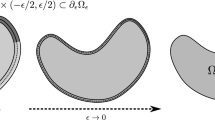Abstract
The Galerkin finite element method (GFEM) owes its popularity to the local nature of nodal basis functions, i.e., the nodal basis function, when viewed globally, is non-zero only over a patch of elements connecting the node in question to its immediately neighboring nodes. The boundary element method (BEM), on the other hand, reduces the dimensionality of the problem by one, through involving the trial functions and their derivatives, only in the integrals over the global boundary of the domain; whereas, the GFEM involves the integration of the “energy” corresponding to the trial function over a patch of elements immediately surrounding the node. The GFEM leads to banded, sparse and symmetric matrices; the BEM based on the global boundary integral equation (GBIE) leads to full and unsymmetrical matrices. Because of the seemingly insurmountable difficulties associated with the automatic generation of element-meshes in GFEM, especially for 3-D problems, there has been a considerable interest in element free Galerkin methods (EFGM) in recent literature. However, the EFGMs still involve domain integrals over shadow elements and lead to difficulties in enforcing essential boundary conditions and in treating nonlinear problems.
The object of the present paper is to present a new method that combines the advantageous features of all the three methods: GFEM, BEM and EFGM. It is a meshless method. It involves only boundary integration, however, over a local boundary centered at the node in question; it poses no difficulties in satisfying essential boundary conditions; it leads to banded and sparse system matrices; it uses the moving least squares (MLS) approximations. The method is based on a Local Boundary Integral Equation (LBIE) approach, which is quite general and easily applicable to nonlinear problems, and non-homogeneous domains.
The concept of a “companion solution” is introduced so that the LBIE for the value of trial solution at the source point, inside the domain Ω of the given problem, involves only the trial function in the integral over the local boundary Ω s of a sub-domain Ω s centered at the node in question. This is in contrast to the traditional GBIE which involves the trial function as well as its gradient over the global boundary Γ of Ω. For source points that lie on Γ, the integrals over Ω s involve, on the other hand, both the trial function and its gradient. It is shown that the satisfaction of the essential as well as natural boundary conditions is quite simple and algorithmically very efficient in the present LBIE approach.
In the example problems dealing with Laplace and Poisson's equations, high rates of convergence for the Sobolev norms ||·||0 and ||·||1 have been found.
In essence, the present EF-LBIE (Element Free-Local Boundary Integral Equation) approach is found to be a simple, efficient, and attractive alternative to the EFG methods that have been extensively popularized in recent literature.
Similar content being viewed by others
Author information
Authors and Affiliations
Rights and permissions
About this article
Cite this article
Zhu, T., Zhang, JD. & Atluri, S. A local boundary integral equation (LBIE) method in computational mechanics, and a meshless discretization approach. Computational Mechanics 21, 223–235 (1998). https://doi.org/10.1007/s004660050297
Issue Date:
DOI: https://doi.org/10.1007/s004660050297




